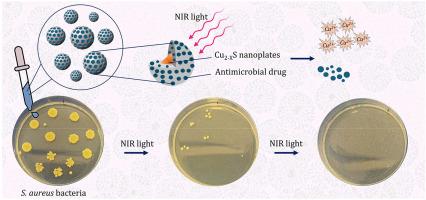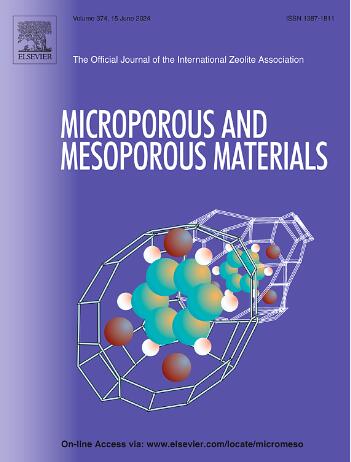嵌入近红外活性等离子纳米粒子的介孔二氧化硅纳米结构:利用抗菌剂输送系统进行光辅助根除革兰氏阳性菌的研究
IF 4.8
3区 材料科学
Q1 CHEMISTRY, APPLIED
引用次数: 0
摘要
由于老龄化社会对骨科植入物的高需求,植入物相关骨感染正日益成为一种严重威胁。植入物表面附着的细菌对传统抗生素具有很强的抗药性,而且越来越难以杀灭。在寻求新的抗菌策略的过程中,多功能抗菌纳米系统为治疗此类感染提供了新的希望。本文报告了介孔二氧化硅包覆质子纳米结构的开发情况,这种纳米结构可用于光辅助治疗骨感染的抗菌药物输送。研究人员合成了以 Cu2-xS 面三角形纳米板(NPL)为核、介孔二氧化硅为壳(Cu2-xS@MSS)的核@壳结构。进一步负载抗菌分子,如左氧氟沙星(Levo)或利福平(Rif),可将 Cu2-xS NPL 固有的抗菌光活性与药物的药理作用协同结合。采用微乳液方法合成的硅基纳米结构得到了全面的表征,并从抑制金黄色葡萄球菌细菌生长的角度探讨了它们的抗菌活性。这些结果勾勒出了这些纳米制剂在治疗骨植入相关细菌感染方面的应用前景。本文章由计算机程序翻译,如有差异,请以英文原文为准。

Mesoporous silica nanostructures embedding NIR active plasmonic nanoparticles: Harnessing antimicrobial agents delivery system for photo-assisted eradicating Gram-positive bacteria
Implant-associated bone infection is increasingly emerging as a serious threat due to the high demand for orthopedic implants in our ageing society. Bacteria adhering to the surface of implants are highly resistant to conventional antibiotics and increasingly difficult to kill. In the quest for new antimicrobial strategies, multifunctional antimicrobial nanosystems offer new promise in the treatment of such infections. Herein, the development of mesoporous silica-coated plasmonic nanostructures for the delivery of antimicrobial drug for light-assisted therapy for bone infections is reported. Core@shell structures featuring Cu2-xS facet triangular nanoplates (NPL) core and a mesoporous silica shell (Cu2-xS@MSS) were synthesized. Further loading with antimicrobial molecules, such as levofloxacin (Levo) o rifampicin (Rif), allowed to synergistically combine the Cu2-xS NPL inherent antibacterial photoactivity with the pharmacological effects of the drug. The silica-based nanostructures, synthesized using a microemulsion approach, were thoroughly characterized, and their antibacterial activity explored in terms of inhibition of bacteria growth against Staphylococcus aureus. These results outline future applications of these nanoformulations for the management of bone implant-associated bacterial infections.
求助全文
通过发布文献求助,成功后即可免费获取论文全文。
去求助
来源期刊

Microporous and Mesoporous Materials
化学-材料科学:综合
CiteScore
10.70
自引率
5.80%
发文量
649
审稿时长
26 days
期刊介绍:
Microporous and Mesoporous Materials covers novel and significant aspects of porous solids classified as either microporous (pore size up to 2 nm) or mesoporous (pore size 2 to 50 nm). The porosity should have a specific impact on the material properties or application. Typical examples are zeolites and zeolite-like materials, pillared materials, clathrasils and clathrates, carbon molecular sieves, ordered mesoporous materials, organic/inorganic porous hybrid materials, or porous metal oxides. Both natural and synthetic porous materials are within the scope of the journal.
Topics which are particularly of interest include:
All aspects of natural microporous and mesoporous solids
The synthesis of crystalline or amorphous porous materials
The physico-chemical characterization of microporous and mesoporous solids, especially spectroscopic and microscopic
The modification of microporous and mesoporous solids, for example by ion exchange or solid-state reactions
All topics related to diffusion of mobile species in the pores of microporous and mesoporous materials
Adsorption (and other separation techniques) using microporous or mesoporous adsorbents
Catalysis by microporous and mesoporous materials
Host/guest interactions
Theoretical chemistry and modelling of host/guest interactions
All topics related to the application of microporous and mesoporous materials in industrial catalysis, separation technology, environmental protection, electrochemistry, membranes, sensors, optical devices, etc.
 求助内容:
求助内容: 应助结果提醒方式:
应助结果提醒方式:


